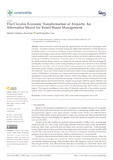JavaScript is disabled for your browser. Some features of this site may not work without it.
| dc.contributor.author | Tjahjono, Michelle | |
| dc.contributor.author | Ünal, Enes | |
| dc.contributor.author | Tran, Trung Hieu | |
| dc.date.accessioned | 2023-03-03T13:21:13Z | |
| dc.date.available | 2023-03-03T13:21:13Z | |
| dc.date.issued | 2023-02-20 | |
| dc.identifier.citation | Tjahjono M, Ünal E, Tran TH. (2023) The circular economy transformation of airports: an alternative model for retail waste management, Sustainability, Volume 15, Issue 4, February 2023, Article number 3860 | en_UK |
| dc.identifier.issn | 2071-1050 | |
| dc.identifier.uri | https://doi.org/10.3390/su15043860 | |
| dc.identifier.uri | https://dspace.lib.cranfield.ac.uk/handle/1826/19259 | |
| dc.description.abstract | Airport terminals worldwide generate approximately 6 million tons of passenger waste annually. Increased awareness of climate change and global interventions for environmental sustainability requires a reassessment of airports’ current methods of waste management. This paper proposes a new design concept solution called circular airport retail waste management (CAWM) for airport terminal retail waste processing, which aims to reduce and ideally eliminate airport waste ending up in landfill or incineration. Given the need for novelty and challenging the status-quo, the double diamond design process was adopted as the research method. The research began by collating the current practices of retail waste processing in airports via a literature review and field observations. Secondly, a critical analysis of the current processes was conducted to identify the intervention points. Thirdly, a concept solution was developed based on the circular economy (CE) 9R framework. Finally, the CAWM concept was delivered to airport waste management personnel for review. CAWM offers a structured way of airport retail waste management practices, including the segregation of nonrecyclable and recyclable waste (i.e., different bin designs, color coding, harmonization of waste colors, improved instructions and signage, various bin locations, training, and installing more liquid disposal and donation stations). Airports can leverage CAWM for greater efficiency and cost-effectiveness regarding airport terminal waste processing, such that more waste can be diverted from incineration and landfill to recovery, which will subsequently help airports achieve net-zero targets. This research contributes to the extant CE literature, especially in the aviation industry context, where the academic discourse surrounding this subject and its peculiarities are limited. | en_UK |
| dc.language.iso | en | en_UK |
| dc.publisher | MDPI | en_UK |
| dc.rights | Attribution 4.0 International | * |
| dc.rights.uri | http://creativecommons.org/licenses/by/4.0/ | * |
| dc.subject | circular economy | en_UK |
| dc.subject | airport retail | en_UK |
| dc.subject | retail waste | en_UK |
| dc.subject | waste management | en_UK |
| dc.subject | zero waste | en_UK |
| dc.title | The circular economy transformation of airports: an alternative model for retail waste management | en_UK |
| dc.type | Article | en_UK |
Files in this item
The following license files are associated with this item:
This item appears in the following Collection(s)
-
Staff publications (SWEE) [2825]

